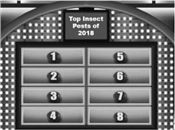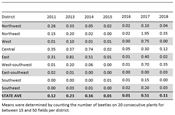|
And The Survey Says…
KELLY ESTES
CHAMPAIGN, ILL.
For those that attended Agronomy Day this past August, the title and above graphic may look familiar. As field and research season winds down, we’re able to finish collecting and summarizing data. One of our biggest summer projects is the annual corn and soybean survey. While some of that information was shared at Agronomy Day, the complete results are summarized below.
As a recap, this survey has been carried out across the state for several years (2011, 2013–2018). In 2018, 40 counties representing all nine crop reporting districts were surveyed, with five corn and five soybean fields surveyed in each county. These surveys have been conducted with the goal of estimating densities of common insect pests. The estimates provided in this article should not be considered a substitute for scouting individual fields and making informed pest management decisions – even areas of the state that appear to be at low risk could have contained fields with high densities of a given insect pest.
As I’ve talked with growers throughout the summer, in their opinion, the top insect pest of 2018 is the Japanese beetle. And both the survey results and I agree.
Within the soybean fields surveyed, 100 sweeps were performed on both the exterior of the field (outer 2 rows) and interior (at least 12 rows beyond the field edge) using a 38-cm diameter sweep net. The insects collected in sweep samples were identified and counted to provide an estimate of the number of insects per 100 sweeps (Tables 1 and 2).
Japanese beetle populations were higher statewide compared to 2017. Western Illinois saw record numbers last year and populations stayed high in 2018. The highest Japanese beetle populations remained in western Illinois, but numbers increased dramatically in the northwest as well (from 54 beetles per 100 sweeps to 175).
Western corn rootworms are always a concern, but populations have been very low in recent years. In addition to sweep samples in soybeans, cornfields were sampled for western corn rootworm by counting the number of beetles on 20 consecutive plants beyond the end rows of a given field – a beetle per plant average was calculated for each field. A mild winter followed by favorable conditions at egg hatch and adult emergence helped the small populations from 2016 gain some traction in 2017 (Table 3). However, per plant averages were lower in all districts again in 2018. Populations were variable. Many fields had low to nonexistent populations, but there were fields with higher numbers. It is important to remember, fields are randomly selected. We have no knowledge of insect management strategies that are used – soil insecticides, transgenics, or foliar applications.
As we’ve seen repeatedly, grape colaspis populations are highly variable. Despite having reports of sporadic larval injury in the spring, adult populations were lower in 2018 compared to last year. We did see more stinkbugs as well as green cloverworms and soybean loopers statewide. While the majority of the stink bugs are green and brown, we did not pick up any of the southern species like red banded and redshouldered stink bugs in the survey. Brown marmorated stink bug was found for the first time in soybean field sweeps in several counties, though.
Funding for survey activities was provided by the USDA National Institute of Food and Agriculture. This survey would not be possible without the hard work and contributions of many people. I would like to thank Illinois Cooperative Agriculture Pest Survey Program interns Evan Cropek, Hannah Hires, Calli Robinson, and Cale Sementi as well as Department of Crop Science intern Matt Mote. ∆
KELLY ESTES: Agricultural Pest Survey Coordinator

Figure 1. What pests were most prevalent in Illinois corn and soybeans in 2018? The survey says…

Figure 2. Average number of Japanese beetles per 100 sweeps.

Table 1. Average number of insects per 100 sweeps on the edge of the field.

Table 2. Average number of insects per 100 sweeps on the interior of the field.

Table 3. Mean number of western corn rootworm beetles per plant in corn by crop reporting district and year.
|
|